#lviv three
Photo

The Chapel of the Three Saints in Lviv by Olena Kulchytska, 1959
#Olena Kulchytska#Lviv#Chapel of the Three Saints#church#Ukrainian Architecture#Ukraine#Ukrainian art#Ukrainian graphic#1950s#linogravure
49 notes
·
View notes
Photo

В. Чорновіл
#monument#lviv#ukraine#lviv ukraine#anticorruption#fight#freedom#leader#20 century#park#lviv city#city view#city walk#city watch#sunny day#three fingers#three fingers up#gesture#hand gesture#pro-democracy#democracy#salute#three-finger salute#вітання#львів#україна#фотоблог#фотографія#чорновіл#зелень
0 notes
Text
(JTA) — As we mark the grim second anniversary of the Ukraine conflict this Shabbat, I’m reminded of a haunting melody I heard in the city of Poltava last month.
I was standing before Sonia Bunina, a plucky 17-year-old, when she opened her mouth to sing when an air raid siren rang out.
I flinched. Not Sonia — she didn’t miss a beat.
“Kol haolam kulo gesher t’zar meod, veha’ikar lo lifached k’lal,” she belted out before seeking shelter. “The whole world is a very narrow bridge, and the most important thing is to have no fear at all.”
Sonia, like so many Jews I know in Ukraine, is many things — determined, grieving, focused — but she’s certainly not cowering.
As she sang those words by Rebbe Nachman of Breslov — the Ukrainian Jewish sage whose followers continue to come by the tens of thousands to his grave in Uman annually — she embodied the prayer’s indomitable spirit.
Sonia and I met outside Poltava’s Hesed, part of the network of Jewish humanitarian hubs founded by my organization — the American Jewish Joint Distribution Committee, or JDC — more than three decades ago. Today they’re a lifeline to tens of thousands of Jews facing loss and strife. Since she was a toddler, Sonia has been attending activities at Hesed — her mother coordinates cultural programs for the elderly, and she connects teen volunteers like herself with isolated seniors, a critical source of comfort these last two years.
These days, traveling to Ukraine feels like a pilgrimage — there’s a pull in my soul to visit family near Lviv, to bear witness to Ukrainian Jewish resilience, and to be inspired by the clarity of purpose that is so palpable there. Since my first trip in 2011, I’ve been eight times. Last year, I wrote about how a year of crisis had transformed the ordinary into the sacred in Ukraine. Now, visiting feels even more essential with the worsening humanitarian situation.
Ukrainian Jews aren’t blasé about these challenges — far from it. Just take the delicate ballet of emotions on their faces when checking their phones during an air alert — contacting loved ones, scrolling through photos of devastation, and analyzing Telegram chats speculating on a given rocket’s make and trajectory.
But life goes on — there’s work to do — and though they’ve lost so much, they refuse to give any more away.
Showing up for each other, whatever it takes, is now baked into their very essence as Jews, and in Ukraine, there are tens of thousands to serve — hungry old women and displaced young families, disabled Holocaust survivors and stunned middle-aged professionals, shocked to now need help when they were once donors and volunteers.
They act fearlessly to ensure their communities make it through this crisis, body and soul intact. Can we expect anything less than boundless creativity from the people who birthed Sholem Aleichem and the Baal Shem Tov?
“These bombings, all these things that are killing people, destroying houses, leaving children homeless … it’s very scary,” Galina Limarenko, an 82-year-old retired nurse, told me in her small bedroom in Berezivka, taking note of the warm blanket, firewood, and other winter supplies my colleagues provided. “Thank God for the Jewish community, which never gives up and always shares even their very last piece of bread.”
I saw that irrepressible spirit again at our Beit Dan JCC in battered Kharkiv — a shapeshifting wellspring of strength just a few dozen kilometers from the eastern border. Shortly after Feb. 24, 2022, the center became a staging ground for truckloads of emergency aid — part of the 800 tons of humanitarian assistance we’ve delivered so far.
A few blocks from missile strikes, it now hosts children’s camps and soulful Shabbat services and operates a “kids hub,” offering academic enrichment to children who haven’t had in-person school for years — robbed of normal childhood by the pandemic and now the ongoing crisis.
And amidst blizzards and blackouts, Beit Dan has also become a “warm hub,” a safe place for beleaguered Jewish Kharkivites to charge their devices and obtain a hot drink and warm meal.
“If you share in our pain, and provide support where it’s needed, I’m forever grateful,” said Nika Simonova, Beit Dan’s program director. “The ability to remain human is the main thing. Done right, I believe that can save the world.”
That’s why we at JDC, aided by a coalition of partners including the Jewish Federations, Claims Conference, and International Fellowship of Christians and Jews, deployed a historic response to this conflict and remain committed to the Jewish future here.
We’re focused on ongoing humanitarian support for more than 41,000 Ukrainian Jews, expanding trauma relief, closing children’s educational gaps, and getting unemployed Jewish community members, among millions of Ukrainians plunged into poverty, back to work.
There is no doubt that the Jewish world is now responding to crises on multiple fronts, including this one, but we have been here so many times before. We must draw strength from our history and from the sure knowledge that this is what we’re built for. Our compassion and commitment, when leveraged with that timeless sense of mutual Jewish responsibility, means we can tackle the challenges we face — and come out on the other side even stronger.
As I walked through Lviv on my last day in Ukraine, I asked my cousin Anna Saprun, a 25-year-old business analyst, how this period has changed her.
“I hate what’s brought me here, but I love who I’ve become,” she said with a fierce and feisty smile. “Nothing scares me anymore. I feel powerful.”
Two years after the conflict began, Ukraine’s Jews are inspired anew each day, resolute in the sure knowledge that they know exactly who they’re working for — each other.
120 notes
·
View notes
Text
Ivan and Phoebe by Oksana Lutsyshyna
Ivan and Phoebe is a novel about a revolution of consciousness triggered by very different events, both global and personal. This is a book about the choices we make, even if we decide to just go with the flow of life. It is about cruelty, guilt, love, passion – about many things, and most importantly, about Ukraine of the recent past, despite or because of which it has become what it is today.
The story told in Oksana Lutsyshyna’s novel Ivan and Phoebe is set during a critical period – the 1990s. In the three decades that have passed since gaining independence, Ukraine has experienced many socio-political, economic, and cultural changes that have yet to be fully expressed. The Revolution of Dignity in 2014 marked a pivotal moment in the country’s history, as it signaled a shift towards European integration and a strong desire to distance itself from Moscow. Prior to this, Ukrainian culture had remained overshadowed by Russian influence, struggled to compete for an audience and was consequently constrained in exploring vital issues.
77 days of February. Living and dying in Ukraine
"77 Days," is a compelling anthology by contributors to Reporters, a Ukrainian platform for longform journalism. The book, published in English as both an e-book and an audiobook by Scribe Originals.
"77 Days'' offers a tapestry of styles and experiences from over a dozen contributors, making it a complex work to define. It includes narratives about those who stayed put as the Russians advanced, and the horror they encountered, like Zoya Kramchenko’s defiant "Kherson is Ukraine," Vira Kuryko’s somber "Ten Days in Chernihiv," and Inna Adruh’s wry "I Can’t Leave – I’ve Got Twenty Cats." The collection also explores the ordeal of fleeing, as in Kateryna Babkina’s stark "Surviving Teleportation '' and "There Were Four People There. Only the Mother Survived."
It also highlights tales of Ukrainians who created safe havens amidst the turmoil, such as Olga Omelyanchuk’s "Hippo and the Team," about zookeepers safeguarding animals in an occupied private zoo near Kyiv, and one of Paplauskaite’s three pieces, "Les Kurbas Theater Military Hostel," depicting an historic Lviv theater turned shelter for the displaced, including the writer/editor herself.
In the Eye of the Storm. Modernism in Ukraine 1900’s – 1930’s
This book was inspired by the exhibition of the same name that took place in Madrid, at the Museo Nacional Thyssen-Bornemisza, and is currently at the Museum Ludwig, located in Cologne, Germany.
Rather than being a traditional catalogue, the publishers and authors took a more ambitious approach. Rather than merely publishing several texts and works from the exhibition, they choose to showcase the history of the Ukrainian avant-garde in its entirety – from the first avant-garde exhibition in Kyiv to the eventual destruction of works and their relegation to the "special funds" of museums, where they were hidden from public view.
These texts explain Ukrainian context to those who may have just learned about the distinction between Ukrainian and Russian art. Those "similarities" are also a product of colonization. It was achieved not only through the physical elimination of artists or Russification – artists were also often forced to emigrate abroad for political or personal reasons. Under the totalitarian regime, discussing or remembering these artists was forbidden. Archives and cultural property were also destroyed or taken to Russia.
"The Yellow Butterfly" by Oleksandr Shatokhin
"The Yellow Butterfly" is poised to become another prominent Ukrainian book on the themes of war and hope. It has been listed among the top 100 best picture books of 2023, according to the international art platform dPICTUS.
The book was crafted amidst the ongoing invasion. Oleksandr and his family witnessed columns of occupiers, destroyed buildings, and charred civilian cars. Shatokhin describes the book’s creation as a form of therapy, a way to cope with the horrors. "During this time my vision became clearer about what I wanted to create – a silent book about hope, victory, the transition from darkness to light, something symbolic," he explains.
Although "The Yellow Butterfly" is a wordless book, today its message resonates with readers across the globe.
A Crash Course in Molotov Cocktails by Halyna Kruk
A Crash Course in Molotov Cocktails is a bilingual poetry book (Ukrainian and English) about war, written between 2013 and 2022, based on Halyna’s experience as an author, volunteer, wife of a military man and witness to conflict.
The Ukrainian-speaking audience is well-acquainted with Halyna Kruk – a poet, prose author and literature historian. Kruk is increasingly active on the international stage, with her poetry featured in numerous anthologies across various languages, including Italian, French, Swedish, Norwegian, Portuguese, Spanish, Polish, English, German, Lithuanian, Georgian and Vietnamese.
For an English-speaking audience, her poetry unveils a realm of intense and delicate experiences, both in the midst of disaster and in the anticipation of it. The poems are succinct, direct, and highly specific, often depicting real-life events and individuals engaged in combat, mourning, and upholding their right to freedom.
130 notes
·
View notes
Photo

A look at the current list of World Heritage sites in danger shows that most are in war zones like Syria, Lebanon, and Palestine. In 2023, sites in three cities - Lviv, Kiev, and Odessa - were added due to the Russian invasion threatening the country's cultural heritage.
by StatistaCharts
122 notes
·
View notes
Text
Lviv Regional Military Administration about the Russian night attack:
According to preliminary data, 18 "Shahed" flew in the direction of the region, 15 were shot down by Ukrainian air defense (7 of them directly in the airspace of the region).
There are three hits on industrial (not military) warehouses in Lviv. One person was injured - a guy who was there at the time of the attack. The fire at the warehouse is still being extinguished




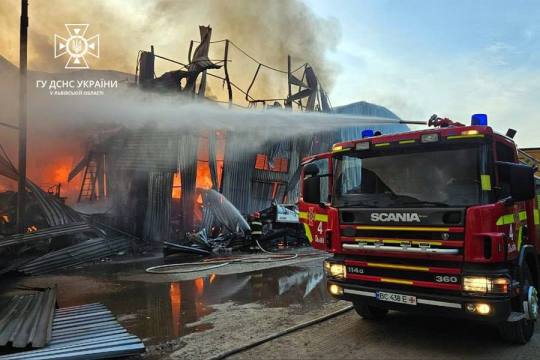
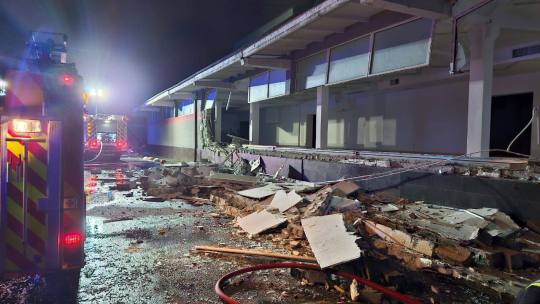
#ukraine#russia is a terrorist state#russia invades ukraine#russian war crimes#russia ukraine war#russian invasion#russian agression#russian terrorism#russia must burn#russia
140 notes
·
View notes
Text
Today it’s the 24th of February, 2 years after the full-scale war started in Ukraine. Most know that this isn’t completely out of the blue, since Crimea was invaded 10 years ago, but let’s go back even further.
During the first world war, Ukraine was torn to pieces, literally, it was occupied by Poland, Russia, France, anarchists, and the Whites, Kyiv changed hands over five times in a year, communication inside and outside the country was almost completely cut off.
This war eventually resulted in the Soviet Union occupying Ukraine. Due to this Ukrainian people fought in the Soviet army. At the end of the war Ukraine did gain some independence, for some decisions, such as being accepted into NATO as Ukraine, rather than as the Soviet Union.
On the 21st of January 300 000 Ukrainians lined themselves up between Kyiv and Lviv, forming a human chain for independence and on the 24th of August Ukraine declared itself independent from the Soviet Union.
In 2004 there were presidential elections between Yushchenko and Yanukovich, in which Yanukovich won, however the results were falsified, and the Ukrainians protested for 2 months, this is known as the Orange revolution. The protestors won, and the elections were re-done, where Yushchenko won fair and square.
6 years later there are new elections, in which Yanukovich wins, again, fairly. He promised that he’d integrate Ukraine with Europe and join the EU. However, in 2013 when he was about to sign the agreements to improve relations with the EU, he made a complete 180 degree turn, and spoke about rebuilding relations with Russia. This, naturally made upset the Ukrainians very upset, so they protested for three months straight. They’d eat and sleep on the streets to protest every minute of every day and night, this resulted in police brutality. Every February 20th the people lost during these protests are mourned for their sacrifices for Ukraine’s freedom.
Yanukovich, unable to resist these protests fled the country, While the population was looking for a new president Russia invaded Crimea, there was a referendum, which was accepted due to the pressure and the country we are dealing with, Crimea was taken, and soon the fight over Donetsk and Luhansk begins.
Then, on the 24th of February, the full-scale invasion begins. Ukrainians have fought strongly, never ever giving up, fighting for there freedom, for the freedom of Europe, fighting for the truth and honesty Russia has yet to show. Take a minute today, after reading this far (thank you for still sticking around!) and thank the Ukrainians who have lost their lives in these battles, those who have lost their lives in merciless attacks, and those left behind.
Now, let’s listen to the experiences of one awesome Ukrainian: Living in war is terrifying, “you stop caring about food, sleep. Just staying alive, only thing that matters. We [Ukrainians are] Europeans. We’re not Russia. We died for this, and we continue to fight, every day, for this. We’re not just some people dying somewhere. We are real! We have our language, our songs, our fairytales. We exist. We matter.
Finally, a line from the Ukrainian anthem: "Душу й тіло ми положим за нашу свободу, І покажем, що ми, браття, козацького роду” Meaning “We'll lay down our souls and bodies to attain our freedom, And we'll show that we, brothers, are of the Cossack nation” Слава Українi!
41 notes
·
View notes
Text
Since yesterday night people all over Ukraine woke up to the air raid alarm because russia yet again started attacking them with Shahed drones.

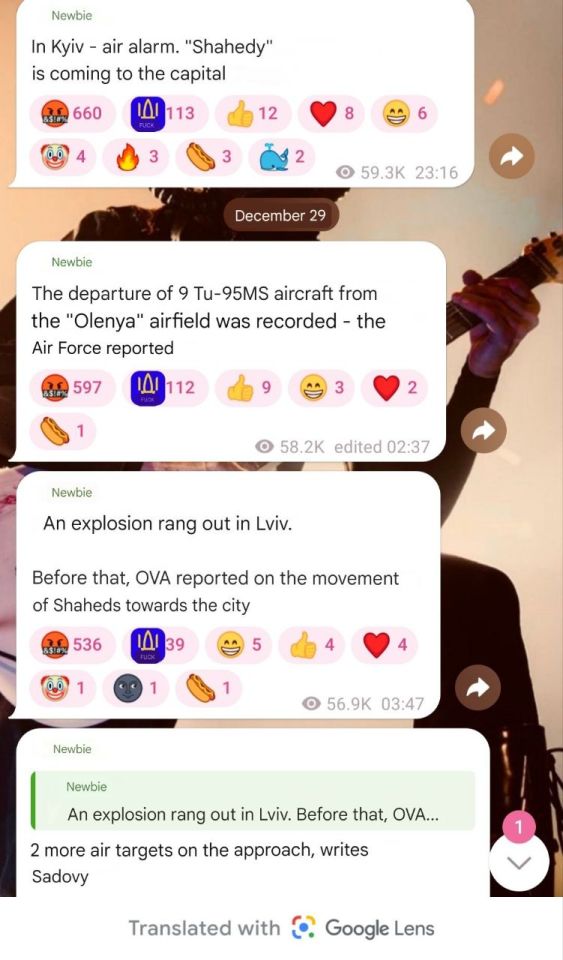
As a result, during the night russia terrorised many Ukrainian cities, such as Kyiv, Dnipro, Odesa, Zaporizhzhia, Lviv and Kharkiv.
Just in one night russia hit Ukraine with 158 missiles and drones.
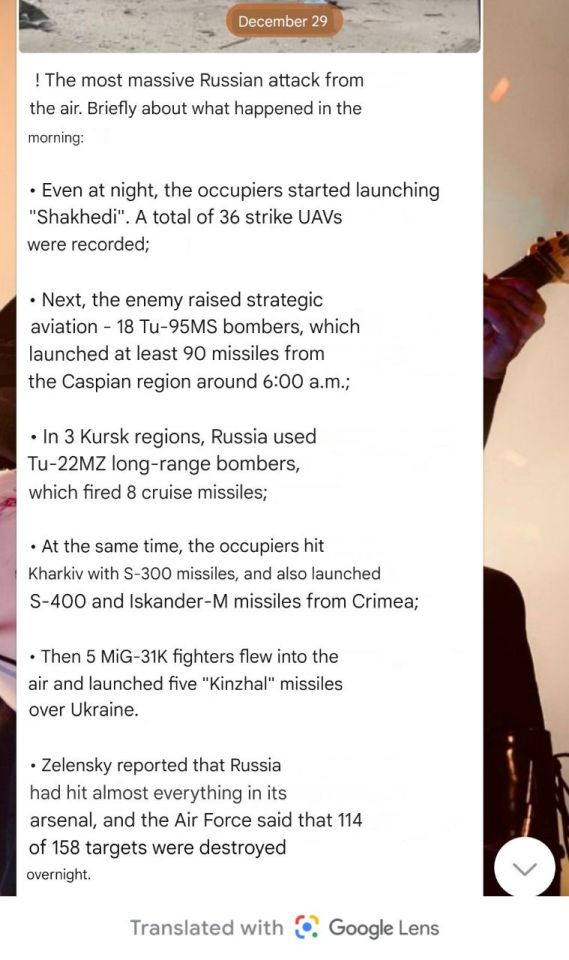
CONSEQUENCES OF RUSSIAN ATTACK IN LVIV:
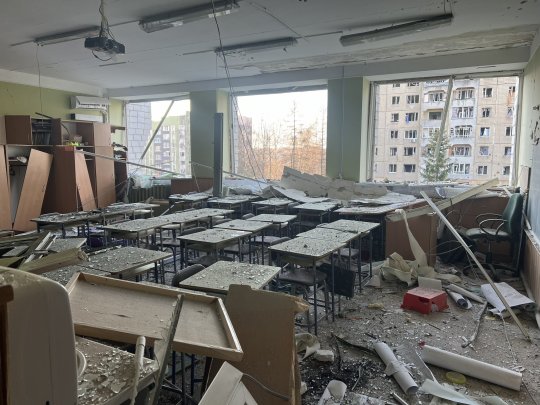


According to the report of the Lviv OVA at the moment:
Residential buildings, three schools and a kindergarten are damaged.
15 people were injured. One person died.
CONSEQUENCES OF RUSSIAN ATTACK IN ODESA:




According to the report of the Odesa OVA at the moment:
Residential buildings are hit. Rescuers unblocked and pulled out more than 20 people from under the rubbles.
The number of dead is 4.
THIS IS BARELY HALF OF THE ATTACKS IN ONE NIGHT. CONTINUATION OF THE POST.
And all this terror in just one night. As I was writing this post (15:00 Kyiv time) Ukraine is already under another wave of air raid alarms.
This is your daily reminder that russian war in Ukraine DID NOT end. It DID NOT stop. It DID NOT freeze. Russia continues to attack Ukrainians , specifically targeting residential buildings, shopping malls, schools and hospitals at night or the most busy hours to increase civilian casualties. Because this is all they can do. All russia can do is make terror.
This post is a reminder that russians don't want peace and don't plan to live in peace with Ukraine. They want to occupy and take away everything from us and what they cannot take they want to destroy.
Ukraine needs your help. Most of all Ukraine needs weapons to protect itself on ITS OWN territory and to fucking cast out russians from our country.
#ukraine#russia is a terrorist state#russian war on ukraine#ukranian#укртумбочка#укртамблер#world politics#stand with ukraine#i stand with ukraine#russian invasion#russian terrorism#russian war in ukraine#kyiv#kyiv ukraine#odesa#odesa Ukraine#lviv#lvivcity#lviv Ukraine#genocide#genocide in Ukraine
48 notes
·
View notes
Text
January 2nd, January 8th and January 13th. It feels like the 2024 year has been going on for more than three weeks already, with each week marked by a massive full scale air raid attack of russia on Ukrainians.
Each night begins the same: a message at around 2 am, reporting from 8 to 11 missile carrying planes getting off at russian airports and moving towards the shooting positions. Then at 6 am the full attack begins. Guided missiles swarm in the air, and around 6:30 am several sonic missile planes also launch the deadly weaponry towards the cities. Our air defenders do their best to protect us and at around 9 or 10 am everything ends.
This feels like nights of hell when you live far away from the frontlines. Cities like Dnipro, Kharkiv, Kherson and thousands and thousands located around the frontlines experience this everyday. But these nights become a nerve-wracking challenge for citizens of every corner of Ukraine (if we don't count all the other air raids which are less full-scaley, less weaponry is launched then). Kyiv, Kharkiv, Myrhorod, Lviv, Khmelnytsky and other cities in the west, north and centre-east of Ukraine have been targeted in these recurring air raids.
About the weaponry, these air raids are different from usual ones because all kinds of weaponry is used by russians during these. Sonic ballistic missiles "kinzhal" or daggers, which you can hear breaking your city apart just two or three minutes after they were launched thousands of kilometers away. These are only destroyed by the Patriot air defense complexes and it's hard af to do so. Our defenders are showing incredible precision but the debris still damages buildings and murders people. Ballistic missiles and guided missiles that can change their direction at any time, even circle around different cities until they are right above the targets. Shaheds, the kamikaze drones. All launched from different parts of russia and from occupated parts of Ukraine.
Personally, I have no right to complain as a person living in well-protected Kyiv, but hearing explosions very close to your home, hiding on the cold floor of the corridor and shaking at the thought that you live on the high enough floor to die in the debris if your home is hit... all this makes me lose sleep at night after I see the dreaded message at 2 am. It hasn't been 2 weeks since the new year but it feels like it's been ages. You try to find new beginnings and motivation to live, but you can't really shake off the feeling that tonight you were lucky to survive but you might not be the next time.
Do I have to repeat how important it is to donate to the Ukrainian army? Do I need to repeat that it's all russians, again and again, killing my people, ruining my home, while others "forgive" them for their horrible deeds? Do I have to say this again, that I'm only here writing this because of all the weaponry given to and bought by Ukraine, due to the support from different countries, and most importantly all the blood and lives of my people given for us to live? What can I do to stop this?
Please, if you read this far, help us survive and win, so that we never have to go through nights and days like these again.
#once again breaching the rules of cold collected news like post by having a mental breakdown in the end#I just wish my blog made at least some difference#ukraine#war in ukraine#stand with ukraine#russia#russia is a terrorist state#fuck russia#russian war crimes#war blog
46 notes
·
View notes
Note
hey, hi! can i ask if hometown in your bio means ''the place you come from but don't live there anymore'' or do you actually still live in Ukraine? peace and hugs, love your url btw
Hello!
I do actually live in Kyiv. I did leave for 4 months last year (the battles in Irpin and Bucha were really close, I literally had spent a week in basements before leaving), first to Lviv for a month and then to Riga for three months, but then I came back home and am still here in Kyiv.
And thank you for the compliments!
22 notes
·
View notes
Text
I want to present you my project of making postcards with Flame-Chasers from game "Honkai Impact 3rd" in traditional ukrainian clothes!
I love Flame-Chasers and what they represent, I love how different all of them are, so I wanted to show my culture through my favourite characters.
I plan to make postcards with every Flame-Chaser, but for now I only have three:
Griseo in the clothes of Chernihiv region, Ukraine

2. Elysia in the clothes of Horodoc district, Lviv region, Ukraine

3. Pardofelis in the clothes of Dolyna district, Ivano-Frankivsk region, Ukraine

#honkai fanart#honkai impact#honkai elysia#griseo#ukrainian#ukraine#pardofelis#honkaimpact3rd#postcards#my artwork#my big project that I procrastinate on for years now#Flame-Chasers are my life
19 notes
·
View notes
Note
Hello dear precious most talented and stunning Anna.
I hope you are well, and thriving as much as this life could allow.
Can I, a mere mortal, ask your highness to elaborate on your latest work of art? And to explain to me -a mere vincible creature- your splendid creation?
I shall wait for your answer, most patiently.
Thank you,
Someone who admires you so much
Mimi, first of all, you're NOT a "mere mortal" (even tho I know you were in the mood for such language, STILL I can't just pass by), you're amazing. And secondly, thank you a lot for asking, I'm so glad to share more about this art, truly. Thank you!
So, the original post here and for the reference I leave the art here too:

So, let's start with one of the most remarkable things here - the embroidered cloth in the background.
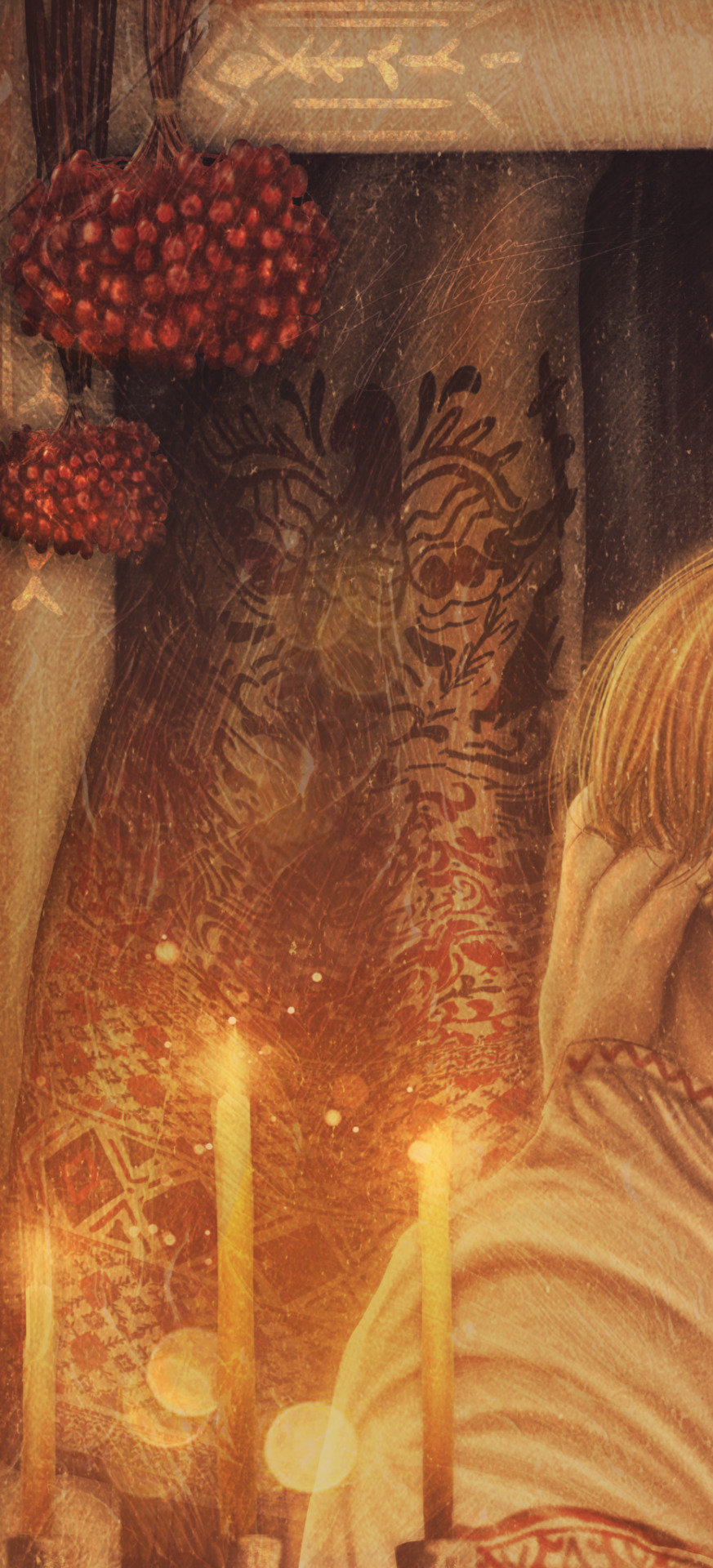

We call it "rushnyk", and it's both a decorative and ritual cloth. Rushnyk, as for rituals, is used for all the major events in life - birth, marriage and death, and we call it like the "line of life", since it has the long rectangular form, that reminds a path, and it leads a person through life. That's why each symbol, embroidered in rushnyk, aside from the specifics of each region that has its own unique pattern, has its meaning, the symbolism, the whole novel in threads, and that's why rushnyk is a part of the inheritance and each house, each family has its own story embroidered in cloth.
Let me tell you a bit of a wedding ritual with rushnyk: for the wedding and during the whole ceremony, more than 20 different rushnyks are used for different purposes (sometimes, it can be even more than 30!), but the most important ones are 4 of them:
- the one for the stepping on it - the most important one, it's a symbolic ritual of the newlyweds stepping on it, like a declaration that they will spend this life side by side together, to show the equal position and respect in marriage. This rushnyk is used only once, for one wedding, only for one newlyweds, and each detail is like the code for their happy future together. That's why this rushnyk is inherited ONLY, for the future generations new wedding rushnyk for stepping on it are embroidered from scratch. And then, this wedding rushnyk is used for the decorative purpose only (yeah... The one that is behind Annie and Armin is THIS ONE rushnyk :3 so you can decode some symbols on it too);
- the one for the icons (well, that is optional, if people are religious);
- the one for tying the newlyweds hands together - works +- the same as the wedding rings and the stepping ritual, to show that the newlyweds are connected, decided to spend this life together;
- the one for the korovai - the special ritual round bread, decorated with several symbols like moon, sun, animals, flowers etc (of course, each symbol has its meaning for the newlyweds and it varies by region). The bride and groom were given the korovai as a blessing before the wedding ceremony. The korovai was shared by all the wedding guests, and this was considered the culmination of the wedding.
But even in general, rushnyks were used like the typical decoration on the wall and could be done also just like for the decorations purpose only, framing paintings, icons, photos, the entrance, like the belief that each symbol on the rushnyk protects people in the photos and the house from the evil spirits and bad luck.
Well, for the whole jewelry thing I already explained here, on this post! For the embroidery of their shirt, it's all the same, but I just want to mention that here, both of them wear the ornaments from the West part of Ukraine, from the Lviv region.
Next, are these specific candle holders - it's a traditional Ukrainian candle holder for three candles, and it originated from West Ukraine, from Hutsuls - the one who lives in the Carpathians mountains, but it's widely used everywhere in Ukraine. The part of the Lviv region also has the Carpathians, so yep!
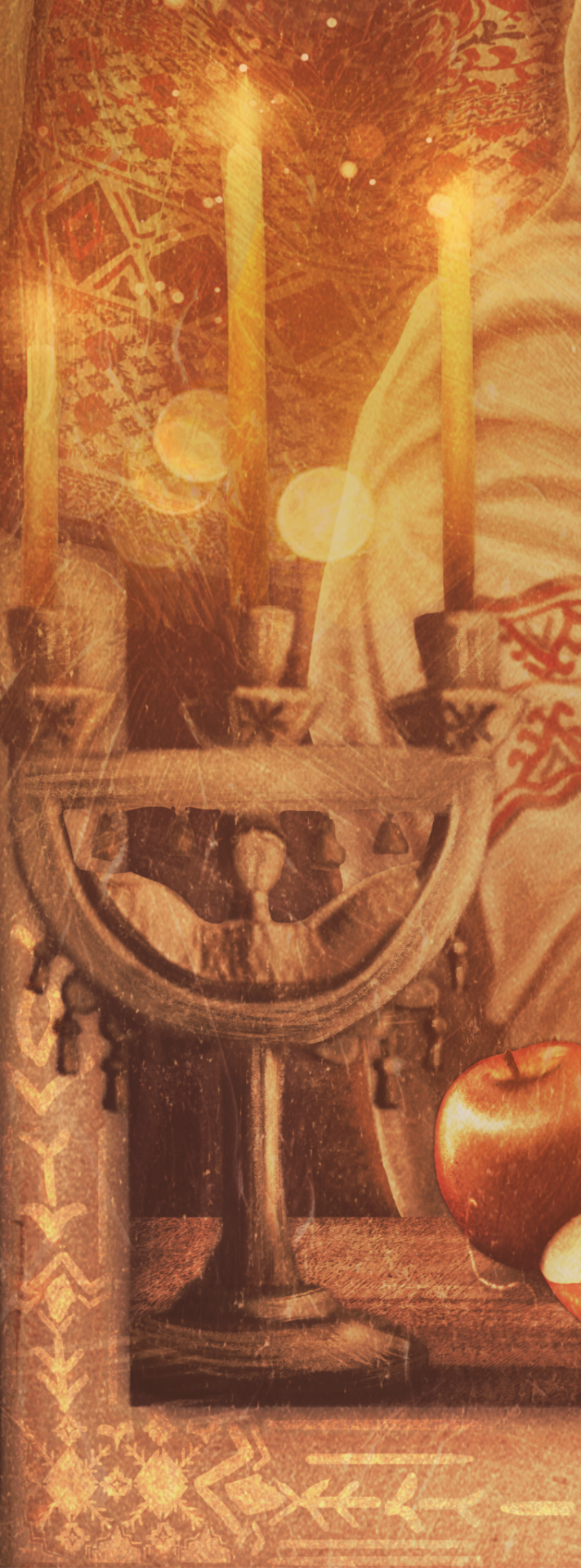
Next one, the bunches of guelder rose, that in Ukrainian is "kalyna".

Kalyna is, actually, an important symbol for Ukrainian culture in general, it's the symbol of love, happiness, respect, eternity, and also a bunch of kalyna is used in the wedding ritual as well, it was for decorations of vinok (ithe flowery crown with ribbons and others decorations), for korovai ornaments, for rushnyk embroidery etc, and also the bunch of kalyna - is a symbol of blood, shedded for the independence of Ukraine.
Also, I need to note another thing, I already mentioned in this post that Ukrainian culture is about layers.
Actually, what we see at Annie and Armin is not only the open shirts but more like the last layer of the clothes, it's nothing but the naked body under it.
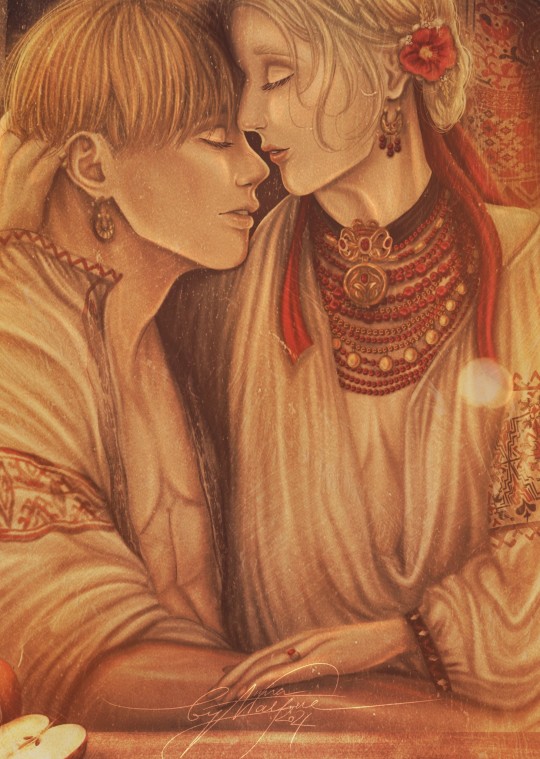
So, based on everything I just said, the whole composition, the lightning, their pose - everything should speak as a frozen moment of their intimacy, sensuality, of trust and respect, and all the symbols and some small details work together to show it, to straighten the whole vibe of their first married night or something like this. Even their opened shirts are not because for fanservice (only) and because I'm down bad for these two, but rather to show their closeness, their trust and admiration, their unity and their vulnerability they show each other with an open heart.
So well, that's it!
Thank you so much for asking, and I enjoyed writing all of it. I tried not to make it boring, so I hope it was entertaining.
#aruani#armin arlert#annie leonhardt#annie leonhart#answered ask#ask#ukrainian traditions#ukrainian culture#ukrainian art#ukraine#украрт#український tumblr#my art#digitalart#illustration
19 notes
·
View notes
Text
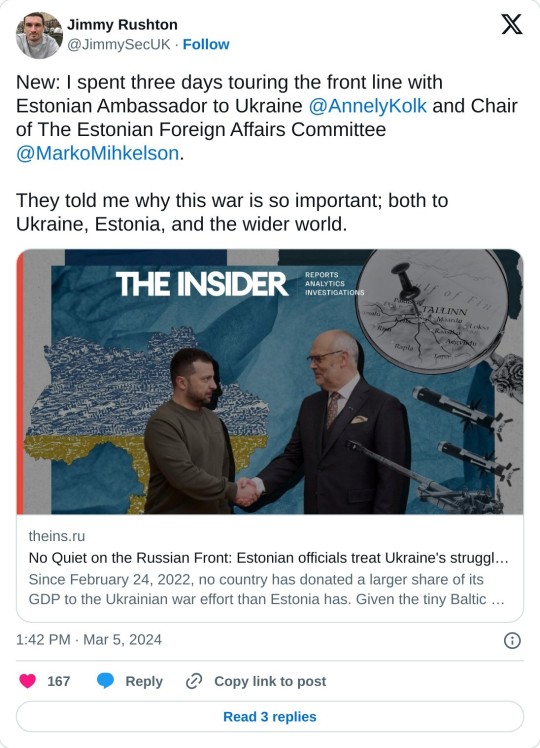
Since February 24, 2022, no country has donated a larger share of its GDP to the Ukrainian war effort than Estonia has. Given the tiny Baltic state’s Soviet-era experience of life under Moscow’s domination, that level of generosity is not difficult to understand. The Insider recently traveled with two high-level Estonian officials on a tour of the front in Ukraine. The experience underscored just how deeply Russia’s other neighbors understand that the failure to properly arm Ukraine is already placing the European Union’s security in jeopardy.
“If all countries did what Estonia was doing, we’d be in Moscow by now,” Mikhail, the commander of a Ukrainian infantry unit currently deployed in Robotyne, told The Insider, only half joking. We’re meeting Mikhail at an undisclosed location to the north of his unit’s positions, roughly 20 kilometers behind the frontline.
It’s one of the last stops on a three-day tour of the front, with The Insider joining Estonia’s Ambassador to Ukraine, Annely Kolk, and Marko Mihkelson, Chairman of the Foreign Affairs Committee of the Estonian Parliament. The trip coincides with what one Ukrainian officer described as the “toughest fighting since the beginning of the full-scale invasion.” As we saw and heard for ourselves, Ukrainian forces are suffering acute ammunition shortages while attempting to hold off an enemy that is stubbornly determined to advance, regardless of the human cost.
The trip has been arranged by a Ukrainian-Estonian group of volunteers, who run the “One Team, One Fight Foundation.'' They’ve been delivering non-lethal military aid to Ukrainian soldiers across the country for nearly two years. The foundation’s director, Dmitro Drey is an affable Ukrainian originally from Luhansk who speaks the heavily accented Russian common for a native of the Donbas region; its co-founder is Harri, an Estonian ex-soldier. Both men have traveled hundreds of thousands of kilometers across Ukraine delivering desperately needed military equipment to frontline units.
Most foreign dignitaries, understandably, will never come as close to the fighting as Drey and Harri do. Many of them would never leave Kyiv or Lviv to travel incognito in inconspicuous, unarmoured vehicles without a security escort. But for both Kolk and Mihkelson, the importance of speaking to Ukrainian troops in person — to get a firsthand understanding of the war — outweighs the not inconsiderable risk. For long periods of time, we were well within Russian artillery range, and the sound of incoming shelling was a disconcerting constant.
For Mihkelson, a reserve officer in the Estonian armed forces, speaking directly to Ukrainian soldiers enables him to better understand the situation on the battlefield, enabling him to be a more effective advocate for the increased provision of Western aid. For Kolk, trips like this one are part of her diplomatic mission. “I’m ambassador to all of Ukraine, not just the capital,” she says. “Sitting in Kyiv gives you an unrepresentative picture of this war.”
And the ambassador is right. Unlike last winter, this year Kyiv has experienced no blackouts and no loss of water supply. The atmosphere on the streets remains relatively calm. If it weren’t for the air attacks — which rarely penetrate the excellent Western-supplied air defense network guarding Ukraine’s largest city — a visitor could be forgiven for forgetting that Kyiv is the capital of a country fighting for its survival.
It’s different in Druzhkovka, 20 kilometers from the battle. Here the sound of artillery is constant, and yet, as in Kyiv, people continue to go about their lives the best they can under the circumstances. A mother and her child walk in a nearby park, while city maintenance workers prune trees. It is a surreal picture. Military aid is distributed to soldiers that have recently come back from their positions in nearby Chasiv Yar, and Kolk and Mihkelson get to hear about the situation in the trenches.
The situation is bleak. Nearly every unit we speak to says that Ukrainian troops are outmanned and outgunned, facing extreme ammunition shortages as they attempt to hold the line against an enemy with an almost suicidal determination to advance.
It’s not difficult to make the direct connection between broken Western promises and the current difficulties on the front line. According to Mihkelson, a lack of Western strategic vision is also to blame. “There’s no clear understanding of how this war should end in Washington or Berlin,” he argues. “We rarely hear that Russia must be defeated on the battlefield.” The constant slow-walking and incremental provision of aid, particularly from the United States, clearly frustrates him. “Why don’t they send some of their own F-16s? They have so many!” Mihkelson says, referring to the American decision not to supply their own fighter jets to Ukraine, instead relying on European allies such as Norway, Denmark, and The Netherlands. “Or the ATACMS missiles that are just sitting in warehouses waiting to be decommissioned.”
The limitations and conditions under which the West has supplied weapons to Ukraine also come in for criticism. In Mihkelson’s words, demands that Kyiv refrain from using Western-supplied weapons to strike targets inside Russia’s internationally recognized borders is akin to asking Ukraine to “fight this war with both hands behind their backs.” It is an opinion commonly shared amongst the Ukrainian troops we spoke to.
As infantry commander Mikhail noted near Robotyne, Estonia’s commitment to the Ukrainian cause stands out. The Baltic country of less than 1.5 million has donated a staggering 3.6% of its GDP in bilateral aid to Ukraine since January 24, 2022, easily the most generous country by this metric (for comparison, the United States has donated 0.32%). “We know this war is existential,” Kolk tells The Insider, explaining Estonia’s high level of support. It is an understanding that permeates every level of the Estonian government. Given the country’s direct experience of Russian imperialism, there is a widespread belief in Tallinn that if Putin is not stopped in Ukraine, Estonia could very well be his next target.
The same is true for Estonia’s neighbors Latvia and Lithuania, both of which have also donated significant amounts of military support to Ukraine while imploring their European and NATO allies to take the threat of further Russian aggression more seriously. For years, the NATO strategy for defending the Baltic states followed the “tripwire” approach — having small numbers of international troops forward deployed to the alliance’s eastern flank not in order to successfully defend against an invasion, but to ensure that any Russian incursion would risk inflicting casualties on British and American active duty personnel, thus bringing the full force of those two military powers into the conflict. But of course, in the event of an actual Russian invasion, the arrival of help from points further west could not have come immediately. “The ‘tripwire’ policy would have left our country occupied by Russian forces,” Mihkelson explains.
The experience of Ukraine under Russian occupation, along with the effectiveness with which Russia has used threats of nuclear “escalation” to delay Western aid deliveries — from the United States and Germany in particular, Mihkelson notes — have led the Baltic States to begin constructing a defensive line of bunkers and fortifications along their countries’ borders with Russia. The importance of Russia not being allowed to quickly take territory, illegally annex it, and then hide behind a nuclear shield is now well understood. Questions of whether an American President would risk nuclear retaliation to support a European NATO ally date back to the Cold War, and the defensive line currently under construction is an attempt to prevent that question from ever having to be answered.
Both Kolk and Mihkelson express frustration at how long it has taken some of Estonia’s allies to appreciate the danger Russia presents to its neighbors. “The West has massively underestimated the threat Russia poses, at all levels,” Kolk argues, paying particular attention to the Kremlin’s information warfare operations. “Here in the Baltics we’ve seen it for years. Russia tries to claim Russian speakers are ‘oppressed’ in our countries, but the truth is Russians living in Estonia have more rights than Russians living in Russia.”
Mihkelson highlights the pattern of Western passivity towards Russia that, in his estimation, led to the current full-scale war in Ukraine. “There seems to be little understanding in many Western capitals that Russia is fundamentally attempting to overturn the current world order,” he says. “This is not only about Ukraine,” he adds, drawing lessons from recent history. “We’ve seen continued weakness in the West’s response to Russia, from the invasion of Georgia, to Obama’s ‘red line’ in response to chemical weapons attacks in Syria. That was clearly a moment when Putin detected weakness.” He notes that, when confronted, Russia has almost always backed down. “We’ve seen so many ‘red lines’ Russia themselves have set down, and then backed away from, when they’ve been crossed,” Mihkelson says.
Towards the end of our tour of the frontline, we arrive at a position close to the town of Orikhiv, north of the highly contested settlement of Robotyne. As we pull up, an M142 HIMARS rolls out towards its firing position. In a testament to the ammunition shortage, only one of its six launch tubes is loaded with a GMLRS rocket. Several groups of Ukrainian soldiers arrive at the meeting point simultaneously. Two young servicemen who hadn’t seen each other for months hug upon realizing that the other is still alive.
Kolk clearly finds the experience emotional. “At that moment I felt I couldn’t hold back tears anymore. My own son is 21,” she says. “I cannot imagine him greeting his friends in such a way.” Except if Estonia’s continuing support for Ukraine demonstrates anything, it is that Kolk, Mihkelson, and hundreds of thousands of other Estonians can all too well imagine that, if Ukraine does not receive the military aid it needs, then the ambassador’s son really could be greeting his friends in exactly the same way in the not-too-distant future.
7 notes
·
View notes
Note
hi!! how are you doing?? how’s yakuza going? (very awkward message but it’s been a while and didn’t know how to word the ask better andjdj)
omg hiii!! things are being quite hectic recently. i took a break from university bc my mental health has gone to shit, got diagnosed with depression and c-ptsd (duh) and currently moving out of my dorm to an apartment with another three flatmates (the rent in my city is disgustingly high)
as for my yakuza 0 progress I'm currently on chapter 7 also known as a chapter in which majima goro is going through Not Good Very Bad Time (doesn't he ever tho). loving it immensely esp the fighting and business minigames. and also substories are hilarious because. i do, too, find myself in some sort of Situations constantly so it's like. ah yeah average tuesday in kamurocho (which I've been jokingly calling the Levandovka district simulator bc this district in lviv is not exactly safe OR sane. same with Sykhiv (another remote city district) but i hate this place with a passion so i assign it the sotenbori treatment.
sorry for a long rant!! how have you been?
13 notes
·
View notes
Text
This night, the Russians hit a high-rise building in Lviv with a rocket. It is known about 8 wounded. Rescuers continue to get people out of the rubble - Lviv Mayor Andriy Sadovyi.
Sadovyi said that about 60 apartments and 50 cars were damaged. An operational headquarters is on site.
It is also known that a critical infrastructure facility was damaged in Lviv, there are previously wounded. This was told by the head of the Regional Military Administration.
UPD: From under the rubble of a residential building in Lviv, rescuers got three dead, said the mayor Sadovyi.
undefined
unknown
#ukraine#russia is a terrorist state#russia invades ukraine#russian war crimes#russia ukraine war#russian invasion#russian agression#russian terrorism#russia must burn#fuck russia#russia
209 notes
·
View notes
Text
Russia-Ukraine Daily Briefing
🇷🇺 🇺🇦 Wednesday Briefing:
- New US-made longer-range bomb expected to arrive in Ukraine
- EU seeks ammunition boost for Ukraine in bid to approach goal
- Macron urges Europe to 'accelerate' aid to Ukraine
- PACE approves draft resolution on seizure of frozen Russian assets
- Three NATO allies sign deal to speed up military deployments to eastern flank
- Ukraine's military spy chief expects Russia's offensive to fizzle by spring
- Ukraine says Russia not handing over alleged POWs bodies from crashed plane
- Ukraine downs Russian Su-34 jet over Luhansk Oblast
- Ukraine's Lviv becomes first region to remove all Soviet-era monuments
- Russia and Belarus to create joint state media company
-----------------------------
📨 Daily newsletter: https://russia-ukraine-newsletter.beehiiv.com/
💬 Telegram: https://t.me/russiaukrainedaily
Socials: https://linktr.ee/rvps2001

#russia ukraine war#ukraine russia war#ukraine war#russian army#russian war crimes#news#newsletter#russia#ukraine
10 notes
·
View notes